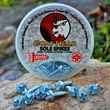For as long as I’ve been drawn to the outdoors, I’ve been obsessed with gear bags and boxes. Likely, it’s a natural evolution of an obsession with gear that most all outdoor recreators come to share. You invest in and depend on specific tools to get the job done, and so you need them organized and protected from damage.
My assortment of gear is as rich and varied as the pursuits available to me in the Appalachian Mountains of southwest Virginia. Over the course of a year, my truck and boat carry gear to outfit me for four fishable seasons that play out in a variety of arenas, from high mountain trout streams and tight, hard-to-access (but floatable) rivers, to major blueways pocked with class III and IV whitewater. They need to carry the essentials—flies, leaders, leader material, reels and spare spools, rods, terminal tackle, nets, waders, boots, anchors, and tow straps—as well as the other items that go into a productive, safe, and enjoyable day on the water.
Largely, a boat box, hip pack, boat bag, and reel bag keep the former items compartmentalized nicely by species and method, but it’s those other items—like propane tanks, cooking utensils, sunscreen, chemical hand warmers, electrolyte tablets, headlamps, gloves, insect repellent, GPSs, ropes, pulleys, backup sunglasses, etc.—that come to litter the dark corners of the truck (and my memory), as they bounce around, serving a variety of seasons and uses. They don’t have a place, though for a few weeks or months, the bottom of a beat up milk crate or the space beneath the passenger seat may act as such.
Enter YETI’s LoadOut GoBox. I first got my hands on this offering from YETI last summer as I was transitioning into a fast-paced existence on the river. It at first seemed to be a reliable storage option for those aforementioned other items—an organizational tool that could migrate from the house to the truck and boat while performing its intended function. But after a year of having it in my arsenal of gear bags and boxes, I am continually discovering new uses for it. Here’s why.
What Works
Organization
The GoBox is deceptively voluminous at 30 liters. A removable plastic divider splits the main, large-item cargo space, which is large enough to hold 10 Plano 3600 boxes, in half. A removable caddy, featuring three deep compartments, comes standard, and three large, removable zippered pockets line the lid to keep smaller items, like lines, maps, papers, leaders, etc., in check. This assemblage of storage solutions has proven to strike the perfect balance between minimalism and options, and is surprisingly great at keeping things organized. There is generally a place for everything, and no dozen, odd-sized pockets that will never be used.
Waterproof
Depending on what role a gear bag or box plays, waterproofing may or may not be necessary, but it’s never a negative. The GoBox features a rubber gasket around the inside of the lid that makes it 100% waterproof, even when submerged for a period of time. So, if you’re using it as a dry box in your boat, or as a tote for expensive camera gear, it’s got you covered. What’s more, should you somehow lose the box overboard, it’s incredibly buoyant, and stays afloat even when weighed down by 50 pounds of cargo (I tried it at the boat ramp with a 30-lb. anchor and several river rocks).
Durable
The more time I spend outdoors, and the more I come to rely on the ability of my gear to stand up to the day-to-day (and my sometimes absent-minded abuse), the less I’m willing to sacrifice on durability. True to YETI’s proven form, the GoBox is incredibly well-built and sturdy.
The latches are firm, closing with a crisp knock from a fist, though easy to open, and I have had zero issues with them since I began using the box. The removable, zippered pouch, which YETI dubs the Pack Attic, is similarly over-engineered, constructed from a thick, durable material, and beefy zippers that are crisp, but not overly stiff. In over a year of use, I’ve had no problems with the material or the zippers.
And though it’s not thick-walled like the company’s rock solid coolers, the build strikes a utilitarian balance between rigidity and resilience to blows. As an added benefit to anglers who enjoy sight fishing and occasionally standing on a cooler to gain an elevation advantage, the GoBox is rigid enough for the average person to stand on, and the dense rubber feet make sure it won’t go sliding around your boat or truck, whether it’s a standing platform, a storage solution, or both. It also has slots molded into the sides, which will take a one-inch NRS strap to secure it to the boat should you be encountering major whitewater.

Versatile
For as long as the GoBox has been in my arsenal, I’ve been discovering new uses for it. Some days, it stays in my truck containing miscellaneous items like tow straps, propane tanks, backup winch straps, headlamps, and a smattering of tools. Some days, I strip down my raft for a float with difficult put-ins and take-outs, and the GoBox replaces my large, heavy, aluminum dry box, and spends the day tucked underneath of the rower’s seat holding my phone, keys, wallet, leader material, flies, terminal tackle, spare fly lines, spare oar locks, and fishing tools. On overnight floats, it serves as a dry goods pantry, storing oil, bread, spices, bags, cooking utensils, and the like. It’s carried camera gear, and has even been used to carry water in a pinch. And once again, it can be stood on, unlike soft boat bags, which is an ability I always value having on the water.
What Doesn’t
Internal Protection
The one thing that the GoBox isn’t designed to do in the field (other than keep things cold) is to protect fragile gear. There is no foam insert or padding, and so if you store a single camera and lens in the cavernous 30-liter box and send it tumbling down a rocky embankment, you probably won’t like the results, but then again, if that’s your intended use, this box is not for you.
Price
Price is always a tradeoff when it comes to gear/dry boxes. They’re typically expensive, and the GoBox is no exception at $249.99 retail. It seems like a lot to spend for a box to keep your stuff in. However, considering this box should last a lifetime, and excels at keeping gear dry and organized, it’s worth the cost, especially if you’re like me and understand that organization saves time and enriches your time in the field. Furthermore, most any comparable, well-built dry box of this size will generally cost between $150 and $300, a cost that is justified the first time it saves your iPhone from being drenched in your non-waterproof bag when a wave comes over the bow or a toad choker of a summer rainstorm rolls over the mountain.
Final Word
YETI's LoadOut GoBox has come to be a reliable tool that fills many roles in my day-to-day operations, both on and off the water. Though a bit of an investment, the GoBox delivers on quality craftsmanship, versatility, and durability, and is a great option for those looking for a do-all workhorse of a gear box.






























Comments